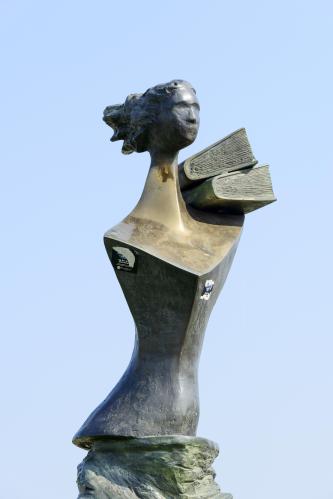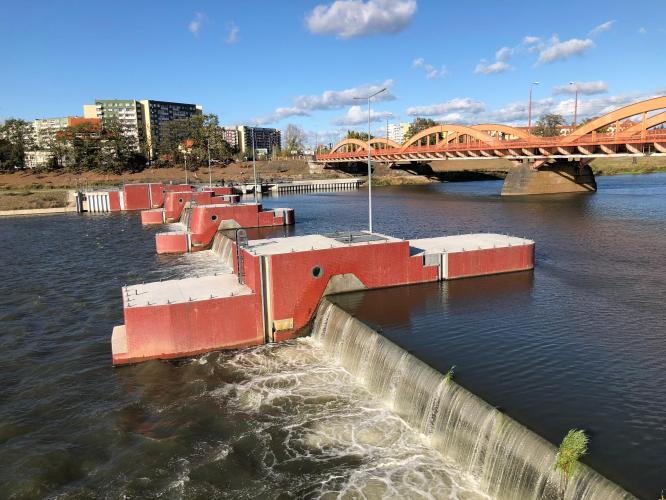This project tells a very Polish tale of resilience. Wroclaw, Poland’s fourth largest city, was among the worst affected by the floods that devastated central Europe in the summer of 1997. In the years that followed the Millennium Flood, the city had to reconquer its riverbanks. It also had to rethink its entire flood protection strategy. JASPERS is proud to have been a part of it, facilitating the provision of 247 million euros in European subsidies. During the traumatic events and since, the people of Wroclaw have shown solidarity and incredible resourcefulness…

The brief
Wroclaw is often called the “Polish Venice”. It is one of Poland’s oldest and richest cities in terms of culture, in a country that is not lacking in that respect. It is also built on twelve islands in the River Oder, connected by canals, over a hundred bridges and a few secret passages.
One day in July 1997, however, water turned against it. When torrential rain started battering Central Europe, Poland had not experienced major flooding for years. More to the point, the country was in a vulnerable position, in the middle of its democratic transition, just eight years after the fall of the Berlin Wall.

As nearby rivers burst their banks, the Millennium Flood had arrived. Wroclaw was submerged in 3 m of water, wrecking lives and devastating the city. Dykes, roads, wastewater treatment plants, power and phone lines were destroyed; 340 000 residents were without drinking water and the risk of an epidemic at its peak.
During the flood, Wroclaw saw the worst but also the best. Thousands of people helped each other out, sometimes in heroic ways. The students even rallied around to save books from the old library. When the waters receded, they left behind an apocalyptic landscape but also inhabitants who knew they could unify. A city full of anonymous heroes.
The challenge
A flood is a peculiar individual shock, as it literally obliges you to throw your sludge-covered life in the bin. The collective trauma however is similar to that setting in after other natural disasters. It involves the fear of a repeat event and distrust of the authorities and their ability to predict and protect. The challenge clearly had two faces: regaining safety and trust at once.
The Polish authorities themselves launched a reconstruction programme the following year, and then, from 1999, a global flood protection strategy. They also called on JASPERS in 2010 to bring each part of the strategy into line with EU criteria, unlocking access to 247 million euros in Structural Funds.
The action

To protect the city from future floods, one had to think big, to the scale of the entire river basin. The strategy elaborated with support from the World Bank, among others, includes three core measures:
- The flow of canals running through Wrocław was improved by deepening, extending and reinforcing their banks, strengthening several bridges and modernizing the locks and weirs. The Odra river was also widened and dredged, whilst the water boulevards in the city centre were strengthened, so as to improve the stream of the river.

- Existing dykes were strengthened and new ones built, both upstream and downstream of the Odra river. A new bypass was also created whilst the Widawa river valley was adapted in order to safely channel excess water from the Odra river to the valley.
- A 26 km2 dry polder was created in Raciborz, able to contain 200 million m3 of water if necessary, thus reducing any flood wave significantly.

JASPERS role
JASPERS water engineers and economists reviewed and influenced every stage of this triple major project, from the feasibility studies and options analyses to the official EU subsidy applications, together with the financial and environmental analyses.
As ever, their role was also diplomatic. Water does not stop at administrative boundaries, nor do the climate, economy, tourism or solidarity. It was therefore necessary to overcome the inevitable disputes and ensure that the local, regional, national and EU authorities were all on the same page. One might call this solidarity and resourcefulness too.
The 247 million euros of European subsidies came in addition to 93 million euros from the national budget and 305 million euros in loans from the World Bank and from the Council of Europe Development Bank.

The results
The Oder basin strategy is now operational, despite there being stumbling blocks along the way. World War II bombs were discovered at the bottom of several canals and defused, and chemicals found in some parts of the river had to be treated, leading to delays.
The transformation is already clear. The renewed riverbanks, bridges and locks have given the city a new lease of life. The marshy banks have been turned into green spaces with cycle and jogging paths. Some plots of land even became buildable, and are now the site of riverfront homes. Restaurants and shops gradually sprung up too. In short, water went back to being an asset for the city Wroclaw.
The post-traumatic stress has given way to a feeling of confidence, quality of life and even economic boldness. The project even put an emphasis on environmentally advanced materials and technologies, like the five ladders created to enable fish to traverse the locks. The city and the planet’s future are envisaged without the fear of floods. That is what resilience is all about.
Now what could be more logical than seeing the EU's experts and budget supporting this transformation? One of History's greatest stories of resilience is, after all, the European Union itself.